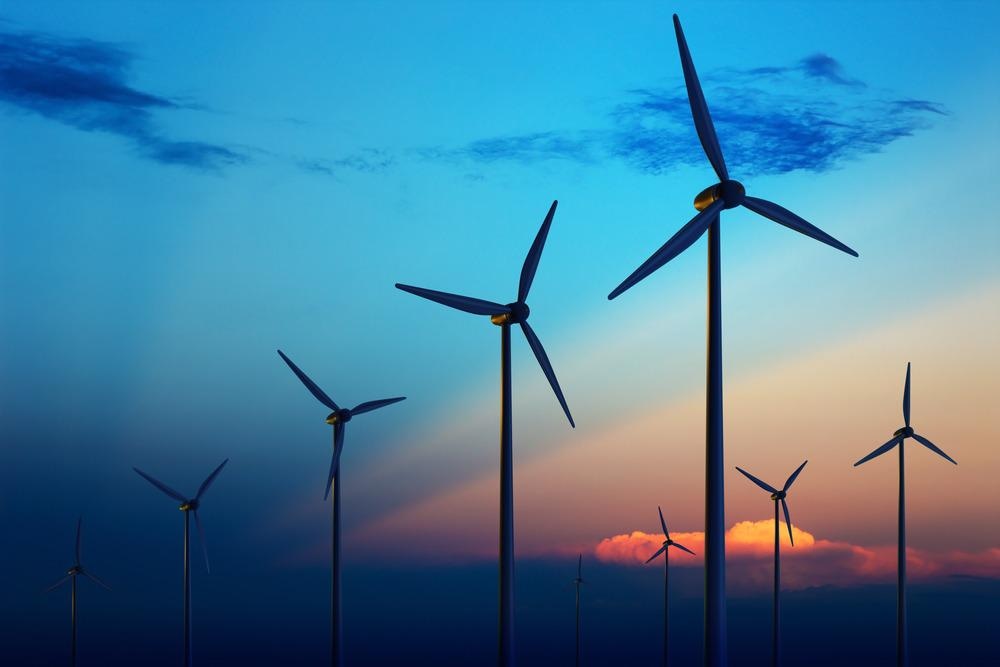
Image Credit: Johan Swanepoel/Shutterstock.com
The wind energy industry is awaiting the installation of the first-ever natural fiber composite nacelle in a Harbor of Rotterdam wind turbine in Amsterdam in spring 2021. The installation is the result of innovative engineering and materials solutions that could pave the way for natural fiber composites in more sustainable wind turbine production in the future.
The nacelle is the part of a wind turbine that houses the components necessary for energy generation. These include the drive train, gearbox and generator, as well as the brake assembly. Like wind turbine blades, nacelles are typically very large parts made of composite plastics over a light wood core. They must be able to withstand high mechanical stresses without the degradation that leads to inefficient power generation.
Natural fiber composites have been used in place of plastic and carbon fiber composites in several industries with some success, notably in shipbuilding. They are a more sustainable alternative due to their lower carbon footprint for manufacturing and better suited for recycling once they reach their end of life.
The natural fiber composite nacelle that will be installed in Rotterdam is not only the first nacelle made from natural fiber composites ever manufactured, but it is also the largest known natural fiber composite structure produced to date.
Sustainable Wind Turbine Materials Needed in the Wind Energy Industry
Generating electricity from wind power requires large and lightweight wind turbines to efficiently capture enough wind power. This requires advanced engineering and materials, such as is seen in shipbuilding and aerospace design.
The manufacture and end of use considerations of such materials have typically performed poorly against sustainability goals. Manufacturing large structures such as nacelles or turbine blades is highly resource-intensive in terms of energy needed to create molds and the use of rare materials and natural resources in the plastic materials themselves. The plastic composite structures of these large components also make recycling too prohibitive to be viable.
The first generation of wind turbines has seen its positive environmental impact reduced by lack of sustainability in wind turbine production and materials. However, as the oldest of these are now nearing the end of their lives, the wind energy industry has an opportunity to limit this reduction and maximize its positive environmental impact.
A key strategy for sustainable wind turbine production is simple maintenance and repair. Ensuring existing (and new) wind turbine structures last as long as possible will save costs and mitigate the negative environmental impact of manufacturing and replacing turbine components.
Finding more sustainable wind turbine materials is another important strategy. This is a complex matter due to the high engineering requirements for nacelles and blades – they must be large, strong, and very lightweight.
Natural Fibre Composites: Sustainable Wind Turbine Materials?
Natural fiber composites may hold the answer for sustainable wind turbine materials. Made from natural materials, the carbon cost to manufacture is much lower than plastic composites. Rare materials and resources such as oil also need not be used in natural fiber composites. Recycling these materials is also much more viable, with good-quality material obtainable with conventional recycling methods.
Greenboats – a Dutch natural fiber composites expert – was commissioned in 2020 to engineer a solution for putting natural fiber composites in wind turbines. The company required a nacelle made from natural fiber composites – the first of its kind and largest natural fiber composite structure to date.
The nacelle would have to satisfy DNV-GL load cases for offshore wind turbines. Engineers had to ensure it could withstand wind loads of up to 200 km per hour and loads on guard rails up to 2000 kg. To meet these requirements, Greenboats worked with Sicomin to provide the epoxy material.
Founder and managing director of Greenboats, Friedrich Deimann, said:
For a structure like the nacelle, it was critical that we selected materials that process consistently and perform well in large scale components, and that is where Sicomin are so strong."
Friedrich Deimann continued: “Their resins, gelcoats and clear coats meet our sustainability targets, and match our NFC ethos, with no compromise on performance. And when we need to scale up, they can really supply on an industrial level.”
Confidence in Sustainable Wind Turbine Production for the Wind Energy Industry
After testing and demonstration in Rotterdam, the first natural fiber composite nacelle will move to its long-term offshore setting. Greenboats hopes to create market confidence in using natural fiber composites for sustainable wind turbine production with this project.
Greenboats will accompany delivery of the nacelle with a full evaluation of the component's design and manufacture. They will continue to drive forward sustainable wind turbine production by engaging more wind power providers and presenting their case for natural fiber composites in wind turbines.
References and Further Reading
Ganesh, R Kalagi, Rajashekar Patil, and Narayan Nayak (2016). “Natural Fiber Reinforced Polymer Composite Materials for Wind Turbine Blade Applications.” International Journal of Scientific Development and Research. [Online.] https://www.ijsdr.org/papers/IJSDR1609005.pdf
Mishnaevsky, Leon (2021). “Sustainable End-of-Life Management of Wind Turbine Blades: Overview of Current and Coming Solutions.” Materials. [Online.] https://doi.org/10.3390/ma14051124
“Sicomin and Greenboats Collaborate to Develop NFC Nacelle for Wind Turbine.” (2021). Special Chemistry. [Online.] https://omnexus.specialchem.com/news/industry-news/sicomin-greenboats-nfc-nacelle-000223980
Disclaimer: The views expressed here are those of the author expressed in their private capacity and do not necessarily represent the views of AZoM.com Limited T/A AZoNetwork the owner and operator of this website. This disclaimer forms part of the Terms and conditions of use of this website.